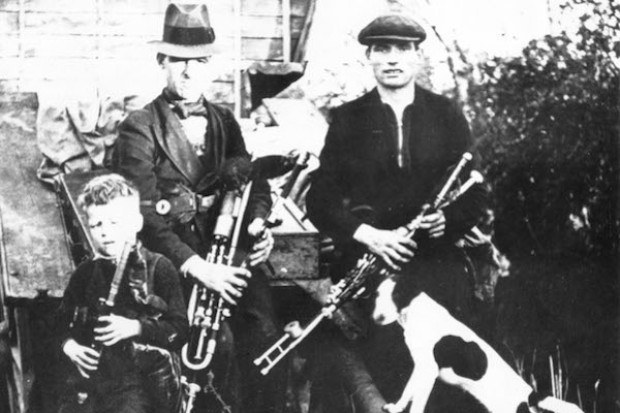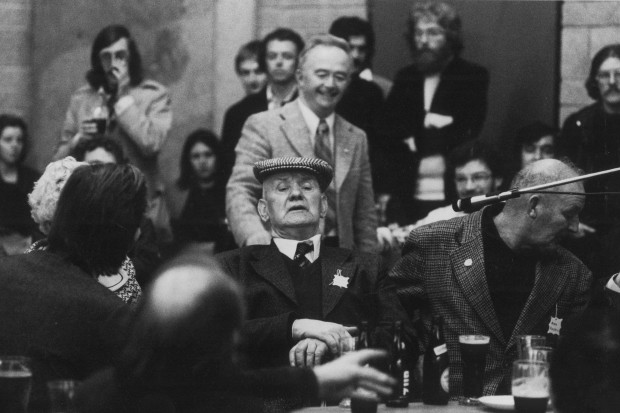A Reply to Bob Quinn & Jean-Yves Bériou
I would like to apologise for any offence caused by my review of Mr Bériou’s two CDs by Sarah Ghriallais and Josie Sheáin Jeaic Mac Donncha, since none was intended. I would additionally like to express my regret at not naming Bob Quinn. Atlantean and Mr Quinn are both actually referred to in the biographical notes for Josie Sheáin Jeaic, but it was a disservice both to Mr Quinn and to Mr Bériou that I did not specifically refer to this work.
The article referred to and quoted by Mr Quinn, ‘Raising One Higher than the other: the Hierarchy of Tradition in Representations of Gaelic and English Song in Ireland’, co-written by myself and Anthony McCann, and excerpted on Dr McCann’s website (www.beyondthecommons.com/twotrads.html), must be judged in its own right, when the full text appears in Global Pop, Local Language, edited by H. Berger, M. T. Lieber and M. T. Carroll, from the University of Mississippi Press, next August.
However, I would point out that I have published my views elsewhere, and that I stand by them.[1] Might I also add that these are exactly that – views – and so form part of a much needed debate on traditional song and, more widely, music in Ireland. Mr Quinn’s views also make a stimulating and imaginative contribution to that debate, which I have followed with interest, but with which I happen to disagree. As both he and Mr Bériou have acknowledged, my disagreement was expressed in the context of a deservedly positive evaluation of both CDs.[2]
Kevin Whelan has pointed out how various regions of Ireland have been invested with an authenticity denied to others in the areas of sport and traditional music. According to him:
It would appear that the co-option by the state or nationalist movements has an inbuilt dynamic of standardisation which is inimical to the heteroglossia of regional styles and traditions in popular culture.[3]
Building on this observation, I have argued that the tacit promotion of one region within the Oireachtas competitions is another example of this ‘inbuilt dynamic of standardisation’. I have written that this dynamic has at least three elements: (1) The high standard of singing among competitors from Conamara and the Aran Islands; (2) The large numbers of singers from this region participating in Oireachtas competitions; (3) Arising from (1) and (2), the popular perception that such singing is better, i.e. older and more authentic than other varieties. I also maintain that this antiquity and authenticity are believed to inhere essentially in the aurally striking melismatic passages particularly characteristic of South Galway sean-nós styles. I contend that this dynamic is detrimental to the appreciation given to other regional varieties and that it has contributed to their decline. Mr Bériou in his response also appears to agree that the dynamic of competition may be harmful to all singing styles. Consequently, for me, the hierarchy so bluntly articulated by Mr Quinn is more than simply a matter of competing inter-provincial rivalries.
Regarding my views on Ó Riada, I also, like others, have publicly acknowledged his enormous positive influence.[4] Notwithstanding my debt, in Our Musical Heritage I find a definite implication that Munster airs are musically superior to those of Connacht because of their wider musical range. ‘Carraig Aonair’, the lament of a father for his sons who drowned near Fastnet Rock, is one of the simplest airs in the Munster repertoire, and yet is very highly regarded among singers.[5] In light of the esteem in which this song is held, the implication that musical range is the foremost indicator of quality becomes questionable, as does a purely formalistic treatment of music in isolation from text and interpretative discourse among singers. I do not believe that Galway singers have any inferiority complex about their regional tradition. My suggestion in the review was that some Connacht songs did not seem to me as ‘compressed’ as Ó Riada had stated.
Regarding vocal dynamics, in Our Musical Heritage, Ó Riada is not consistent in his views on this feature. He claims on one hand that sean-nós singers do not use dynamics (p. 23), while on the other, he sees dynamics as an unusual ‘survival’ in West Munster singing (p. 38).[6] Vocal dynamics may also be heard on at least one of Seosamh Ó hÉanaí’s/Joe Heaney’s recordings.[7] In Ó hÉanaí’s case, are they to be regarded as ‘survival’ or as modernist ‘decadence’? Or did he choose to use this technique because, as a master singer, he deemed it appropriate in the context? Perhaps it is none of these things, but the questions highlight problems that deserve to be explored and re-appraised.
As has been shown by Edward Said, the European gaze towards the ‘Orient’ has a particular place in the Western imagination, which may be traced back to antiquity.[8] According to Said, the ‘Orient’ represents the Other, the exotic antithesis of the ‘European’ in all respects, and also, significantly, its inferior. Because of the ‘West’s’ (i.e. Europe and America) greater economic strength and its colonial interests, Orientalism has become a way of thinking and writing about the ‘East’, managed and controlled by the ‘West’ and determining the ways in which the ‘Orient’ informs the Western imagination.
Such ways of thinking become so accepted that it is difficult to see that there might be different and perhaps more equitable ways of discussing Eastern cultures, including music. The celebration of traditional song in the Irish language primarily as the Other of industrial urban modernity, in my view, shares many of the same troubling features as Orientalism. Anyone making external claims for similarities between, for example, Eastern singing and the singing of the Irish-speaking regions of Ireland, is implicated in the discourse of Orientalism, however inadvertently. Readers do not always interpret authoritative texts in the ways that authors intend, so that invoking the ‘Orient’ from an external viewpoint, in a comparative manner, may contribute powerfully to limiting the expression and ways of being of particular cultures.
For the record, the Irish World Music Centre at the University of Limerick created the position of sean-nós singer in residence in 1995. It was the first of its kind, and has since been emulated by NUI Galway. The first holder of that position was Dara Sheáin Choilm Mac Donnchadha, or Dara Bán, of An Aird Thoir, Iorras Aithneach. He was chosen because of his unique contribution to the richness of sean-nós singing. It was also a recognition that Galway singers, and particularly the singers of the parish of Iorras Aithneach, or Carna, held a pre-eminent position in Irish sean-nós singing. The IWMC, through the Toyota Ireland fund, financially supported the making of a film featuring the life and singing of Dara Bán, with additional finance provided by TG4 and RTÉ. As Director of Ionad na nAmhrán at IWMC, I was closely associated with this project, as were other members of the Centre.
In conclusion, may I add that lively debate and discussion in the spirit of a love of song and music can only serve to increase the vitality of sean-nós singing and other genres of music. I welcome the space JMI has provided to air disparate and dissenting views on these issues and hope that such a vigorous conversation may continue.
Notes
1. Lillis Ó Laoire, ‘National Identity and Local Ethnicity: The Case of the Gaelic League’s Oireachtas sean-nós singing competitions’ in Brian. A. Roberts and Andrea B. Rose (eds), The Phenomenon of Singing 2, St John’s, Newfoundland: Memorial University of Newfoundland, 2000, 160-170. See also, Lillis Ó Laoire, ‘Up Scraitheachaí: An tAitheantas Áitiúil agus Náisiúnta i gcomórtais amhránaíochta an tSean-Nóis ag an Oireachtas’ in Micheál Ó Cearúil (ed.), An Aimsir Óg, Dublin, 2000, 66-78.
2. The CDs in question, by Sarah Ghriallais and Josie Sheáin Jeaic Mac Donncha, are distributed by Cló Iár-Chonnachta in Ireland and can be purchased from them. Visit their website at www.cic.ie.
3. Kevin Whelan, ‘The Bases of Regionalism’ in P. Ó Drisceoil (ed.), Culture in Ireland – Regions, Identity and Power, Belfast: The Institute of Irish Studies, 1993, 5-63.
4. Ita Kelly, ‘Songs from the Island’, Irish Music, December 2000, 48-49.
5. Diarmaid Ó Súilleabháin, Bruach na Carraige Báine, Indreabhán: Cló Iar-Chonnachta, CICD 1995, Track 12.
6. This inconsistency may have to do with the editing of the text. I note with interest that Richard Pine has found the original recordings quite different from the printed text (‘The National Ear: Part II’, JMI March/April 2003, 22).
7. Seosamh Ó hÉanaí, ‘Caoineadh na dTrí Muire’, Sraith 1, Dublin: Gael-Linn, CEF 028, Taobh 1, Traic 3.
8. Edward Said, Orientalism, New York: Vintage, 1979.
Published on 1 May 2003
Lillis Ó Laoire retired from his post as professor of Irish at the University of Galway in 2023. He has published widely on song. His most recent book, a collection of essays written in Irish and Scottish Gaelic, edited with Philip Fogarty and Tiber Falzett, is 'Dhá Leagan Déag: Léargais Nua ar an Sean-nós' (Cló Iar-Chonnacht 2022).














